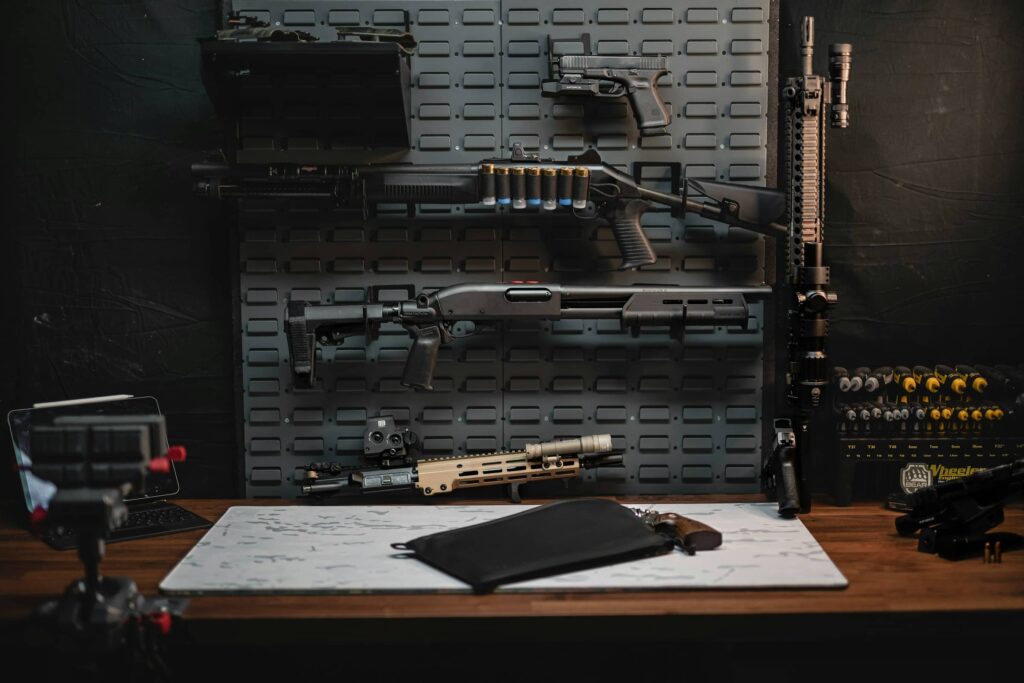Passed in 1938, the Federal Firearms Act marked a pivotal moment in establishing federal licensing for gun manufacturers and sellers. It targeted “prohibited purchasers” and enforced record-keeping that shaped future legislation. Understanding the Act’s historical context with its multiple provisions reveals its lasting influence on U.S. gun regulation.
This article will explore how the Federal Firearms Act’s principles are seen in modern gun control policies, affecting lawmaking decisions and regulatory practices today.
Table of Contents
Historical Context and Enactment of the Federal Firearms Act
The 1930s in America was a period marked by significant social and economic upheaval, which led to increased scrutiny of gun use and ownership. The era saw a rise in organized crime and gang violence, fueled in part by Prohibition. High-profile criminal activities and infamous figures, such as the likes of John Dillinger, supported lawmakers goal for more stringent control over firearms. These events underscored the federal government’s necessity to implement comprehensive gun laws, paving the way for the Federal Firearms Act (FFA) of 1938.
The Federal Firearms Act introduced several key provisions that laid the groundwork for federal gun regulation. It required gun manufacturers, importers, and dealers to obtain a federal firearms license (FFL). The FFA also mandated that these licensees maintain records of all firearm transactions. Importantly, it prohibited the sale of firearms to “prohibited purchasers,” including individuals with felony convictions, thereby setting an early precedent for background checks. These measures aimed to curb the illicit distribution of guns and ensure accountability among gun sellers.
The significance of the FFA in shaping future gun legislation cannot be overstated. It established a federal framework for regulating firearms, influencing subsequent laws like the Gun Control Act of 1968. Its legacy continues to inform current discussions about balancing Second Amendment rights with public safety concerns.
Overview of major events in the 1930s that influenced gun legislation:
- Rise of organized crime and gang violence
- High-profile criminal activities
- The impact of Prohibition
Key provisions introduced by the FFA:
- Federal licensing for gun manufacturers and sellers
- Record-keeping requirements
- Prohibition of sales to certain individuals
Impact and Legacy of the Federal Firearms Act

The Federal Firearms Act (FFA) of 1938 played an important role in shaping subsequent gun control legislation. It set a precedent for federal oversight of firearms by establishing licensing requirements and prohibiting sales to certain individuals. This foundation was crucial when the Gun Control Act of 1968 was enacted, which expanded upon the FFA’s principles.
The 1968 Act introduced minimum age requirements for firearm purchasers and broadened the categories of prohibited persons, incorporating those with mental health issues and certain misdemeanors. By building on the FFA’s framework, the Gun Control Act addressed gaps in the initial legislation, further tightening regulations around firearm sales and ownership.
The FFA’s influence extends beyond its immediate amendments, as it continues to inform modern gun regulations and debates. Its legacy is evident in the ongoing discussions about the balance between gun rights and public safety. The principles established by the FFA remain relevant, especially as policymakers consider new legislation in response to the evolving gun environment in America.
Federal Firearms Act Amendments and Legal Developments
The Federal Firearms Act (FFA) of 1938 laid the groundwork for future gun regulations, but it was eventually repealed and replaced by the Gun Control Act of 1968.
Why was the FFA replaced? The FFA was replaced to address emerging issues in gun control and to expand upon its original provisions. The 1968 Act introduced stricter controls, such as minimum age requirements for purchasing firearms and an expanded list of prohibited individuals, including those with certain mental health conditions. These amendments aimed to create a more comprehensive regulatory framework for firearm transactions and ownership across the United States.
What legal challenges have influenced gun control policies? Significant legal challenges have shaped the interpretation and enforcement of gun control laws following these amendments. One of the major developments was the Firearms Owners’ Protection Act of 1986 (FOPA), which aimed to ease some of the restrictions imposed by the Gun Control Act.
FOPA limited federal oversight and inspections of gun dealers, while also prohibiting the creation of a national registry of gun owners. Legal interpretations of these amendments continue to influence debates over gun rights and regulatory practices.
| Amendment | Impact |
|---|---|
| 1968 Gun Control Act | Introduced age limits and expanded prohibited categories |
| 1986 Firearms Owners’ Protection Act | Reduced restrictions and limited federal oversight |
The Role of the Federal Firearms Act in Today’s Gun Regulations
What are current federal firearms transportation regulations? Federal firearms transportation regulations today reflect the rules established by the Federal Firearms Act (FFA).
The FFA’s influence is seen in the requirement for proper documentation and adherence to specific guidelines for interstate transport of firearms. The ATF continues to oversee these regulations, ensuring compliance and preventing illegal trafficking.
How do federal laws interact with state regulations? Federal laws provide an blanket that states build upon to address their unique concerns. This interaction creates a layered approach, where federal standards set the baseline, and states can implement additional measures to suit their specific needs.
How do FFA principles guide modern firearms legislation? The principles of the FFA continue to shape modern firearms legislation through accountability and oversight. These principles are embedded in current laws (like the Gun Control Act) that regulate the licensing of gun dealers, record-keeping, and background checks.
Final Words
The Federal Firearms Act laid the groundwork for today’s gun control legislation. From introducing licensing for gun dealers to establishing the concept of prohibited persons, its influence extends far into today’s legal frameworks. The Act not only inspired the 1968 Gun Control Act but continues to inform modern debates and policies.
Understanding these historical and ongoing impacts sheds light on the complexity of current gun laws. The FFA remains a touchstone in the evolution of regulatory measures, highlighting its enduring significance in shaping firearm policies.
FAQ
Is the National Firearms Act of 1934 still in effect?
The National Firearms Act of 1934 is still in effect as a federal law regulating specific classes of firearms.
Why was the National Firearms Act of 1934 passed?
The National Firearms Act of 1934 was enacted to regulate certain firearms and address growing concerns about gun-related crimes during the Prohibition era.
What did the Federal Firearms Act do?
The Federal Firearms Act of 1938 mandated federal licensing for gun manufacturers, importers, and sellers. It prohibited sales to certain prohibited purchasers and required record-keeping by licensees.
What are the new federal gun laws?
Current federal gun laws involve regulations on firearms transportation, sales, and which individuals are permitted to own guns, influenced by past acts like the FFA and the Gun Control Act of 1968.
Is the National Firearms Act of 1934 a federal law?
Yes, the National Firearms Act of 1934 is a federal law and remains a significant part of U.S. gun regulation.
What guns are exempt from ATF?
Certain antiques and non-firearm models are exempt from ATF regulation under federal law, but this can vary with changes in legislation or specific circumstances.
What was the difference between the Nation Firearms Act (NFA) and Federal Firearms Act (FFA)?
| Act | Focus | Key Regulations | Goal |
|---|---|---|---|
| National Firearms Act (1934) | Specific weapon types | Required registration, background checks, and taxes on items like fully automatic firearms, short-barreled rifles, and silencers | Discourage ownership of dangerous weapon types |
| Federal Firearms Act (1938) | Broader firearms trade | Required licensing for dealers, prohibited sales to certain individuals, and mandated record-keeping of firearms transactions | Regulate distribution and prevent high-risk access |
- The Right Gear for Upland Hunting - December 21, 2024
- How to Get a Suppressor in a Few Steps - December 5, 2024
- What is The Protection of Lawful Commerce in Arms Act? - November 15, 2024




